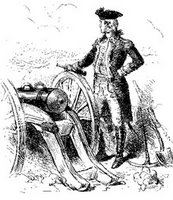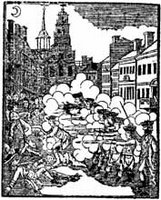"Nothing Remarkable" about Gen. Washington
 Most histories of the American Revolution mention only one event from July 1775: the arrival of Gen. George Washington in Cambridge, where he assumed command of what at the same time became the Continental Army. The lithograph to the left, from 1876, reflects that view of the new commander’s importance. Boston 1775 has had little to say about Washington this July, however. That’s because the new general’s arrival in Massachusetts wasn’t treated as so momentous at the time.
Most histories of the American Revolution mention only one event from July 1775: the arrival of Gen. George Washington in Cambridge, where he assumed command of what at the same time became the Continental Army. The lithograph to the left, from 1876, reflects that view of the new commander’s importance. Boston 1775 has had little to say about Washington this July, however. That’s because the new general’s arrival in Massachusetts wasn’t treated as so momentous at the time.
In fact, lots of people didn’t even take notice. Here are the entries for that week from the journal of Pvt. Samuel Haws of Wrentham, Massachusetts.
the 29. Nothing remarkable this day.Washington arrived on 2 July, and formally took command of the army the next morning.
the 30. Nothing hapened only there was a Smart shower.
JULY.
the 1. Nothing remarkable this day.
the 2. Dito.
the 3. Dito.
the 4. Their was a flag of truce come out of town to our centry on the neck.
the 5. Nothing worth a mentioning to day.
the 6. Nothing remarkable this day.
Haws noted the major skirmishes of the month, even when he wasn’t involved. On 25-26 July, he mentioned a couple of other general officers: first his company and three others “marched toward cambridg to meet general [Artemas] Ward,” and the next day “General [William] Heaths regement moved from Dorchester to cambridg and Jeneral Wards regement moved from cambridg to Dorchester and took general Heath’s Baracks.”
Not until 23 November did Haws find anything to say about Washington:
Being thanksgiveing I went with Serg[eant] Felt up to newtown and kept thanksgiveing their and returnd to our Barricks at night and we had not ben a bed long when our captain came to us and ordered us all to Lye upon our arms by order of General Washington Lesemo of the American Army incampt at cambridg and roxbury and other placesIn that passage I sense a touch of grumpiness about being kept up on orders of the generalissimo (a word Haws was still learning to spell).
Why did Haws show so little interest in (and perhaps knowledge of) his new top commander in July? As a private, he might have seen that change as too far above him to worry about. Some New Englanders might have viewed the installation of this new general from Virginia as a political matter, a way to cement the support of the Continental Congress, not necessarily bringing long-term consequences. (The press seems to have given more attention to Gen. Charles Lee, who arrived at the same time, because of his European military career and his epistolary debate with Gen. John Burgoyne.)
I suspect another reason for Haws’s lack of excitement stemmed from how he was stationed in the southern part of the ring around Boston. The officers there tended to act independently of the command in Cambridge. Gen. Ward’s orders would arrive, and the regimental commanders in Roxbury would have a counsel to discuss whether they were ready to sign on to those plans. That attitude might have filtered down to the men. When Haws wrote of “the general” on 14 June, he meant Gen. John Thomas in Roxbury, not Gen. Ward.
That loose command structure hadn’t produced any breakdowns yet, largely because the New England militiamen were so united in their goals and outlook. But among the jobs Washington took on were instilling more military discipline and hierarchy in the New England ranks, and integrating those men with troops coming from Virginia, Pennsylvania, and other colonies. Only then was he truly commander-in-chief of the Continental Army.










